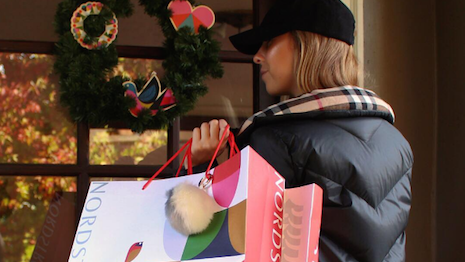As retailers sought to attract shoppers during Black Friday weekend, the most successful sales drivers were direct marketing pushes through email and SMS.
According to data from Oribi, the retailers that saw the biggest uptick in sales were those that sell more expensive merchandise, valued at more than $500. While retailers are investing in social media advertising, search engine marketing and direct messaging were the most effective at actually driving conversions.
“Our analysis showed that purchase rates slightly dropped in the middle of November, indicating to us that consumers prefer to wait a week to get a better deal,” said Iris Shoor, cofounder/CEO of Oribi. “In fact, our analysis revealed that online stores with an average product price of over $500 dollars saw their highest sales peaks, for the year, on Black Friday and Cyber Monday, underscoring that consumers wait for the discounts that come with these two retail holidays to make more expensive purchases.”
Sales spike
Black Friday shopping begins about a week ahead of Thanksgiving, with Oribi finding an uptick in purchasing from Nov. 23 to 28. However, during the middle of the month, shoppers appeared to hold back on buying, most likely due to waiting for promotional deals to kick in.
Fashion stores saw about a 500 percent spike in sales on Cyber Monday, but these retailers’ sales were comparatively closer to average on Black Friday.
While Cyber Monday is a bigger shopping day for online sales in the U.S. than Black Friday, shoppers in Asia make 7.5 times more purchases on Black Friday than Cyber Monday.

Cyber Monday and Black Friday are integral in the holiday shopping season. Image credit: Nordstrom
In Europe, Oribi found that purchase rates fell 20 percent during the week ahead of Black Friday, pointing to the comparatively lower popularity and prevalence of the shopping holiday overseas. In Europe, there was also significant pushback and protests of consumerism, with Green Friday demonstrators potentially influencing retailer and consumer behavior.
Globally, conversion rates are highest on Cyber Monday, with 2.6 percent of visitors making a purchase. Comparatively, conversion rates on Black Friday are 2 percent, and an average day sees conversion rates of 1.3 percent.
During Black Friday and Cyber Monday, online shoppers are more apt to add items to their carts, but a smaller portion of the consumers who place items in their baskets convert than usual.
About 11 percent of visitors add items to their cart on Black Friday, compared to just 6 percent on a normal day. Six in 10 shoppers with items in their cart will head to checkout on Black Friday, compared to just 54 percent on an average day.
While 42 percent of those that make it to checkout complete their purchase on an average day, this portion is only 31 percent on Black Friday.
Mobile was a key channel for the weekend, with 60 percent of digital shoppers using their phones to make a purchase.

Lots of Black Friday shoppers used their phones to buy. Image credit: Ogury
Previous research found that consumers are shunning bricks-and-mortar stores this holiday season, with more than 95 percent choosing to buy half or more of their gifts online, according to a new survey.
The study from multichannel engagement platform Leanplum showed that millennials and Gen Z U.S. consumers lead the shopping trend. More than 16 percent of those two generational cohorts are only shopping online this holiday season (see story).
However, shoppers were not only shopping online. Mobiquity found that mall traffic was up 91 percent.
"Published retail sales figures suggest a decline of in-store Black Friday shopping, but our data suggests the mall is still a destination for families and Santa visits, even if they may not be going there to shop," said Paul Bauersfeld, chief technology officer of Mobiquity Technologies. "Our data is confirming the transition many malls are making to family entertainment centers."
Traffic drivers
According to Oribi, retailers see about the same percentage of new shoppers on Black Friday weekend as they do normally. Additionally, consumer behavior around number of visits before a purchase stayed the same, with about 55 percent buying after just one session.
Bloomreach found that during the weekend of Black Friday, browsing made up 49 percent of traffic. Search comparatively comprised 20 percent of traffic.
Most ecommerce visits happened at night, with about one-fifth of total traffic.
Oribi found that conversion rates were the strongest for shoppers who arrived directly, whether through a retailer email or direct navigation to the Web site. This could be partly due to this audience’s high intent to buy.
Following direct channels, Google drove the strongest conversion rates. Paid Google placements were slightly more effective at driving sales from visitors.
In previous research, ForwardPMX found that search engines, particularly Google, drive more than half of all referred visits to luxury brand sites year-round. Organic search accounts for 57 percent of this, while paid search is responsible for the remaining 43 percent (see story).
Compared to direct channels and search, visitors from social channels including Facebook and Instagram were less likely to translate to sales during Black Friday weekend.
Another direct channel seeing investment in SMS. Analysis from Omnisend found that marketers saw an average click-through rate of 14 percent for texts.
Additionally, shoppers’ order rates were 592 percent greater for SMS messages than for email marketing.
"These results validate that SMS is a rapidly growing channel with a lot of potential for ecommerce marketers," said Rytis Lauris, CEO of Omnisend.
"We saw SMS earning higher order rates than email campaigns during Black Friday, something that's never happened before now," he said. "Ecommerce marketers would be wise to capitalize on SMS by adding it to their marketing strategies."
{"ct":"MM8hfZaBZ\/P9U3uWwQIEQ0ppLuVQyXAq0BLmmdLAp8FlUdeFkZFjTulqr54CFBqvKzST9vp31zlN9rqyrGSxJhLtiq2MY3noTSXHi6FocRt7qLq6yNNfbpfQ3rNrCDLCHN6hYYk2GNfkBc4Ah5M\/KU9bc2KeMf\/uYHbuUuxyaE79KsP04tbcXWNrCznlfiYBRUg2377HM\/fPdDdnF29\/UAQe62nVccE8DvTC5mPDpssmdV2pH+lKy4cOX50Wj7z4jeh4nREpjLqZQMho+XjIG+uaCHcRsA7Qm5BzjgiS99d2ebvN1qTp9f4TfNRN+eAlNKXL4XMXardgZhNANL79kqbeNO0QhmLFd61gGoutne7Sat0edrRTz70EuRnj09RSyj76bpojAyVtWTR+IMUXriragBN5QhuPwcPKg+79j8uVTLZM8uuzjsNHrIXlS8LMXK16CJXqd1Okhb4lcEIlfgN\/Oy\/efeisXxvb9mOmFDcjYNkbTywsYDAGNe\/FNrdvn79KHICaKaWoXFFI3bG9JPK5Y2HwifVoVOhppooB3xvDjL9PaZgXZ0qc95f7SwQbfyM3igCizdV917JoJNHSi38BEx1bPrLvsZMCGnaiv\/kQl1aF39xwmnp0NWYVKEQqNAYrry7zzAMa17Hk9Y+zFzoFlPy\/xeEoQvE0tWgz4sD0h0SIgH8qD2LyYFkFo7CPgrpcbb\/W2mXGOsCixxyY5Lrxn7cVNG5Sey29M4Pa\/gYaDNP1UjkFE+OviiQ1RgpsGbzd7bLXml4r\/Jknp+BUb5rNv5vVU5uQSoxRnMNJ7zSLnsR9quxIECI1\/umm8fNA6Hee4vlMD1ERk2fJRRpPWThIVJx0yC0ZIt4FkpIm3FlHN+qMrM8zEGu+I7C4qV5V4ZW0lh\/rMMfVB8ovCwP+ew5RxRsvHEp1nOw5v3BM6FbG30b81pfd6jITh9rLLagw8XrZYs48SnZUhnGw60mXa7DZaqcQC69g7s3lPggcNSNhzcnXXkacrJmnuqnzdb+V+mzR\/4goPM4EbZ4QEiA\/+dy\/6uH0Frw9iSFWPMl+1S3Ew4OVDfHjogp0m8\/Xc2DF6R26dq+xS7EmItP9aXPNX73tQ41PazD0gOJ2\/wHMw12IAbZBntPauSrwarnZU80gIPTsSf5fYGKQskJ2RQHEl4\/bRXBqWpIx\/IsyXLbAahcNXB9Pbd2YUcjawbOfPVS8dO2Y6jkiMtcps0oBisRnDiHGuiAN0xb9iFLJ2YqAlGnoX9JZ2u\/fPCT2MZJY5gQupFVW7Q+R2w1rfdUd3HJ6QbARgHL0ED1FEOKN5EB+fmOkZ22ix+TbGRmZY56hnZ3crpTijwpxH9Cg\/P00+KsEUvZnpnVFRJatobveoP2JqkHAk4biRuF7S5VE9EosD0BSgE1NffVskEjfh1EYAuCY49m+rGum4g05FJzZb\/U1qAoFT7NEUfpb0Aov2aExD2tn+ZQ6+1bFp2Z5XvCMvMbg7V1LEXvRvaQMm8FPemwUF0b78Umv0CJc7GPYHR2zEcq9Ehq653j6MGwjjgJECFWJEnImsx2w2Mi4yP1qdbFSYlfplJ3bhCvtWJUAvIu6khlcOZnJ\/X+mFlvcIPCUDmSf9iLd7q5kkFaRuaki0o+OUep1GvU\/0r2898KbYnXOQzHhFQWFl29Cs0\/n5oIbclTwNtSiMkHgq+KubIuf4qwVipdWrw\/+Vu+9wDeRkdH8YkTucWRqXt4OpJ2S702eNgoIz4KDLnkTDBBuA+LZpNI4U9CfqJMbs93iGeuhlFtT1a20CgzcFRPmBpBoI7wk4Z6GNJKPbZlzL4H0NI7GCPP1ad7ElKM+LFEMRNXLkPju0WyagLodMtULNIorxeTG9LnBVTlpiX4pcBmNLtuLz4NquZKRbWa\/KCw\/jCygMtb\/eOefjz1At3qS8Cnj6RM4e+r0P\/ioF94LbL8cPNqOSiNYT4pfB3CNPk1RBLGSvolC6y97j8CgVl52P3iA2ZgkIRMaLAtfs4eVaAGtyVNf\/F6OeMMPDu8bNxDwSz6bvmlIA6WYfpqmYRDDQ+uBy0KjG4zEffzcVb2K0gamLKHwI4IKL+MBiujDIQx4xLT5BKiUkZtBd8z16Pww\/PzvMxGeuSXEET\/GVhjsyLbZmvvcnT7IaggsmojnCJswGqzAgQ7i25f4AX9PIEIgxJtLi+8miqvZ0r8bvLAr9wk\/ZEaaYTf8L3FQa2q7SoTT8ezcDtXk5Lx7CFWcd5EJ4dtVh4W4PZCD9u5lDeB\/qt824cARv9xqXfYOHxA1lWZIfK5r4d0a24ptEAYfJNUNAVPJHid0WXWP0uJwjU+Fwn0BpfG6kGsUFHzP\/B0k13pdouv9wzVJPxuDxrFjcdpqPcELu+kZ6m2OOX5JG0zDZIJYB9LvUG5bigOsYkCkC3s2qAwRzL084dJsOpp0STUVJfEjpZDTwzq6xBjmt+0dVm173zs\/2gLf4q8BML\/wThgJqzx+B85erxmx8S+a9aVLdTbyrqmxw6fPTsa4YaT1gClEAmqMh7LmyA9e1yDp3zRn\/1IWSqsFqm9n60kKTQB8BFaX0Ah1M2irrUle+R8FWYODZq4mPqyDZCKUQ\/Sw55vcdv\/hzVByJjWfxoenwoCHVUOP8FC00\/PDzkdPkrRF9vJFLm2XFtLl9RF7SGECrpeICxE+y4xiMDg+eb0W4\/qLrj9bA1TSqx2hqNW\/V63+QWW3Yj0YMasbcyBUysgrkBoKngP9RmQ1JXGut6nEMOB+mO1PT9jfyJV9fO7i7dbdAZpmXOukGaTnHDwiFRBnLoDISD9BYDgqtxBZlYHJgGsjOm\/wtikOUvOszRx0\/ef14xuK+E83\/8r3N3TJHy1SnJ4Io7xhAbrLULfpNkTosh8TVEjW959nf4Kl3c21ZvfCOG3RxcFtksD5+3NahXuM8zXsniEX\/NqpGxt650lAD3lcUm40dz0xSZjIHaUV7mEkkoT5EN4oU6VKFiOxo85onjP8DH43OCJvlMgP3LXLVXyVCun+hP3iWgNNxtK3cr5QTYMbNl3FCQFBp89K7O9SQmW\/x+G0jRGbwz96vu62iTa3DcrbN5PGh7iLTmftY88hMzqqLdDjWekL0oSab1iH5O2UDRfTjQGknVgkAanXMvusU18GrFzGJSmb+0xwLi5SX0OgJ50jlzW4Npj+shQ0cnegfk41UUKt0P6VGz5wxYsWZnBY9OjQsks5WzYcLSwXMW33POviM8jYjnVP+lr+tP3jvlBubsu5oOjzNH0KEH7+3MVRKFQKNFbg7JF0+OviWBVMtmdW+7BSyAJ9RJfTqvX9fd2QGXSEiq7IPAKnqMctK7+uC0J0zfQfZwKnypZbvAnyvehSN0h50yxefNwpo6IXxrKh3OXzHz+zR\/B7BkgY7J1vcZE5K4YzbgdjH8KDpTOoEr2xaBT54DJVE78zdEjZsB34WFBPcF2L5vL3re4QrwAkFz4CbZBxCzzeGFhEqMLewwstEPlUQhg8Ko9\/BAssi\/Pr0YCauog6prhK\/\/1Gm9PWLtwjfK9qtNfc0Q5yxK1mi4IpKyjI3nYhsuuzGmK4F\/9fUKJVQ2S932oXmpBQd1QkrkXuMBvA7KGpVNNyDKozzTja+4cUPKHKD7n4OTWC6iG9JjEay4AEM0HqC4p4W8T+YdPxa1gJAfvF\/yGdqDPHnT6ZCb95p1RIlhrCTWPsdZUI6ngR3vFxwEmC9JtqGryFcUU\/ujfSj4rPhPn2B66681yh+0gIFlQ9sni3+XsIEH3lY2a6gY43US9U+U1L1JCDevvSaz4WYjQmw\/tA5fGrbgc5BlEZECLjpD0thLb9X1zAT0Q79+vcRzkjPH5be4Qb3Inm8RkAxp\/sqbopbDurO4pzI1IF0iSEhnbsNdTc8GLjxWZjdlKmtBoS+3y3j04f6voS4HRA0aGP3NTzwkI0D7MI2bM0EkaXYC\/JHfRaecaH3fi6oMUOxZo5gakKyjtJ8k8meVhk1rPZxrs+Sd+kxgOMeYK+GOKoBQjJfIa+jwYPQq5FXGdynXMutttQWwA4kogFtvwSoeKZ+PmAToeRlisxhi\/0j9wdEHo6xYoWqxzqqc1pUREi4pA4MP0bjlBYmJ5t6xd2AWPb5EGusgzjcZHEXhF6hvnkD0Z3gTuzMDdCLlaHKOoouKQME2BaDbR2VeTIwNgSxBRyzc2Pu\/syEUEF6u0ZGPLo4Inah1KxkV\/yZEi9K0jrTwI8RlsFQQCKqzhsA+ddUtc7oF1yVcCw7QiYLUTiRDoeJkLR4vsFkPA7xGCAtToohm8mRoXM9RdDuIkWASPjz05TecGyZrYtxz4oi8BZ0rX2vLYgUd8khsVsErIY2vZM3sj+A9wkDYdoj5mRifFGTuEEyHZuOWPUqZJxQWkqa07niuCUPJRzM5SMabDI0qh695l6hGOGvRap+qS9zJUomiSMGHkrGGL1m0c9\/EF2x+KXQ\/\/D6xiVbaATUSknpEFIG2cglBHzHZSpjsGyZo2VKT2HVQsd7GmMbUdCMBTIKqG7fN75STQ2ylHwte2m8Ikd51LCuBRL2BJGSadkrAUp4l92FNjMolyb9gl3uAXfhLrFTKE8ZnHRastNyKhZx5O\/HmL3+UC7Z48JKSW68NTWl7bGyB1DI1CHWpDeFRZaPdMxmubLRMX9FWnpCUUChKA9Lim2FtqLQ96TUeDEoS8PaK\/F\/BgoPcK7t3rbqyOUyavTUq487KRo\/F\/fKCclZE3AV2WnnwrXy6nvIDLPkUolYiJnXj2HBNLNKxEqKwSwuuv40pmlwp\/KEct6p1FWK0w39EOHOhF16KNPBtcZRBSqkU8Y8mSh2V6+fy3MK5OGpD9eGf8F5tGgoRwn177o69PGDxyrwL3LwBEUJydCbqNrIwhKozKEHt31Uixw2Yj2HTDhd3F3W+8u2tv\/0rSXQ3gmTIKnNc1ybsnUJxumZ8nrCPFex5u8WO1Ag88\/fk4opm8rxahFTYy5lYns\/8kQ4x5GQHOyFyvqGS+A7qt6Sql\/qdpJEhWfaMlQ7I0z+pBThmgEGuJ7Z0GOi5OY1XLhyT9FrdIlnn95tOsYe2NWQ5CjgRw6qxUtj3zeDYpG6hsq+hCWBZphkBGaeC33usALO886PKJP43aqksFesAe6u7fUxq37P+hpe6qdiyQO7pREotg8g+VVaq4ocQEOG2q4axkT46A0s08pvqDt69FEmTNy8tMJOsOZDnL1mvo7yOQtZyWxmdYjPeU4I5pPE3qFM+zupU5crCme6KTBPYLrWcobUeGV1JvTJCDyEbKjOjYE+RjNQUN76nfBvIKVt5Nb8b2CtQc3setDTeYSKKZDsqZfp47\/f2XAL8fQQEeGA\/NockAmg0cpm6X2mzwyyCxfxz+b2fn\/mVtM9zmCNTQg21KqqXtlz96suVVVezQPljsYfg98XOlhHyTIxmXWzvjfJgvTQMe6HyerDB8wANsGf6zQeUt+3TIx8TXodixL3ruOhXxH9UrueO4Zf7nWvZtTZM\/\/daX+URIKdl8ZK8r8Rk8p291PIWTU\/qovve1mpOYsYvZYOJllNfo\/G4\/n1Lv4C358dmTsSu2paGtcZmnJ1IpBRzAidyLl0DEYmVLXcI25MuTko2UG1HFDujOVOzwgDNOujuaEVHIID3GKLSkvFM\/Bo63fwWUcF508nIJNxQwVkE945PYga3FU+9ryqyiRzq+Hz2pTA\/9\/q8Bvkg5LQOsLlosPdQus6jqRDnPFn7SvFcF9e8BBr+dU46pvjyLR\/\/Hnp5Arf2LZv5F6PjBH7WcfY0Bu7MGbM77jBtQDKit5DdriZuj\/zUlhkwmbOVHVUNi4vN8xHS1W3uCnQ4X2dcCHFlRw25QfX61z7Aoup6S5RAPqLeY5XjIRyuCsso2hvRNQWvLfCld7yWVq2b+afK6Q44mUctdl04bp+Jq+LmGH7olrGzHsjoB6XiIG2s9GEcJAoHErPU0xTMW36SPIHUEoXrUNRDWBhR5lIBvLAPd21Inb4MUSqdMVvhxu\/yNzC4dEuNIFe2cSy\/hsWStUfMmjSeNelPSBXfizIVY4MTtkbPd7lk7mPa53\/6KwJkUged7bGPopT5\/pRtJErbnbDcvHpfzpJpnYYDkT9o6VxgVI6m5IDaoaT0hXxLUzq4YV+SKZe\/jWxiKu3HY1OUfLhhRgbi9ZmkBbjgcB78QuO0kE4mZMMM+TKZVB+VNxlcRXw1izyRiVhlmzYRfqG87ytKaR+++r4Ljd1bhU5kR9GDEhIoRzUrnGp\/S8G1SAsVeX3wikE5PLwuEhHeDEraxejZJGRY7PwKyD0+W\/d1Ruz04M2uG3+gplyMrQZtH7aRGIixKIKKd5DaBVnI3+tX\/9zMM\/EHNCJP9V3HvwO\/wEPtZtB+2r1zCm2HYnrBy15RRueqi2nIKE65aFwcF8qR4bxGNL8hfC+Agi3gVdQYfKFaTrogetgp\/R4epFiCcY8mwQcCOnBgLpSoZ4jadW6ya+apUE84luCnuKxftP8nzcm1fZTu1cV9Tc5NOo+8mdv\/fNHAZqK3Fc4PoQZZVB+mJGdfnUeL2IeOtsKwIimUKNYdcviumEMkJDVIFA6aEUMAvlkm4J7HRgUisegGAYiueQwzfroGfepqcFQuywO1CsodxC8R8twIw+XpqASVNldQsmsvAoBFdzadoJooPyr5GoTIlBBsANftJMDGavg7qGYDhZqowZYTCnO\/hJ\/voKf4OPTf31pmvKMhaolXqghcLLQVgF+o6H304JHnQ+9vjRSCR6l8XFddAeLWPjbCcvJZhBKkpQ1H+rPM7r+JFW9ybKh8IbQ2UzDCM56BJ8Aucp0kwPAeUNVyviilAKz+xNDRXoi3ZQJauCjfScRAg3H+rjWINt3x4DBzFTS3Zqurm9g6KOZs+Xo9KXJSjmGhtetEvQYv+7LhHiZZkJz1N8LMPR8IyTuQZSH+te5Ok2p+r12cyB1mf5waij\/AHjmgYI+8Bm99WbNH6NXquyEkD\/5jo7LoMsfjbUi0JZDwdTS6Iy5eJLVUihthcp5qsBO6c+w2p0zS0TYS50Pxfkg\/QrEZhyxSXxXQVIkUQAxJmQG1bEQHt0sevQzM5neFzV\/RTpJIId4b7TJ2BT57LbNdQtkhjC58tJm18Eo1s4u\/ZWJhLHe1y3+lWbdD5PqEZOHQm66dQh6vKJlgWcuwtDurH0H5yo6uV\/pyTB1+b7H+x\/T6lsUqjVn0ilbTJn639L9wDvV7rJa2nq\/UYUK8+vFrsEGwlbMuAvYIx3V1DC4kKfeYxZVF\/HYqxyYS8yePsaYhzrfeEjMxMqQSIfvxHq5CA+kB74rrQGJdypDpdyWAFOqPvNU29jCe1z6\/KOC4Wn0Xk+dmlU11IPToAF2Gqz6zs68vkzu7hmUzQIhU24VYLg0on7lH9TgDW9S534zjQIUU90rq0YcWDH7XJgM75blPkMUzhH\/4TgDsG17vBXMovhJxHccTVh9DvmWd9zxKPOE4llt7rIs68OPLGT4UHAmxrw\/r8\/xNpVLUbD77rCj7cb5XmiJsE3FqnT1uYqt83hnBMONU5KeYlW6\/rIR1E\/o\/IFzD7k4T84wNR2z8E93fVRsKstk9samhYpqL84V0zRXWG8Rp+ybGWc81x6hbZui4WfqdnPS\/MIje4IQFr7SWHhxeSwiKRzerSP0a2fCG29x8v8onBDawMdxgeMqa9F47jGFjW4e+Zl4WLlY0TXycoIDsaoGoKBoN4ffqRP0zGoy3qF6TOdvUeJTCEZdq6HI60qB1E4AwVFJOcKabVlwLEwq0CcbpzueiozQwkM7m5aRmms3xgfVNtWOw9dUlwQh6zFFYwdgaWKToRYfzVYvZ79DnU69hJvUHZhuXOYEz0y9uO4IwIKFXD22c7Jena2rjcv\/TJUPyzZNwcbwWfDhmrBglvlk7nsdpzSbxz2agYdQr2g3TLpcWwfyRoLXSdbuCCqB\/AA6\/xH2D2OZ75FVKCjLGemPj7Tbc7DcCgmKkw4\/7B4Tlbbcy9LsXpp1CCxuyiyFxCLR8aPRNUrd1\/Ubd+qhg7eWTVAX+iAuh1E08640wSnLjxdx846pvKk272jO1tYfwDabaPwW6OLvgJSXrlOxuam2\/V3a7hoX2\/1Y2EDQiRBaCTUPPXAzUzdkalshjijcDXJAvy1zOnSgHxjmKE2I2Cpw8nDlRZ9eke+MulpgEX5NnYuJClQByoJfdW9M3OFtE2EEvcDCzGg7d9SwPxezpl\/9cK+DwmIsyiY05gudMyxXkhR+mT+cf5MgclnkhbtihBa55ODcqHV+Jsrfdw2Cgdb9OR+BB7b3pr6GkTmQem7cNcZ9LrX2mddjtPad4kdG2Lo9HB8s3jCwPaX9XrD1yKncLj7tdUpLqtz5+D0MT6N7n+RkfkFEXXVtszuA9XsBILIGedwmN5ws6qrZ6xBI5+QjR3YwrSMePpaB8b44q5V6DPRos05j+1+y3VNccudMb6senP8qtxyhfwGA+6s57wUp5WyePr3ar7VSHZeBPZ0nO95hK9wdKIu0QsWXwEJ+NR+sxMYpb4z\/YqViyphVBLo+N4Rj2kxb4vtKxe1dIotmwVPX9OQwZc9dteaGPPS9lC2SjanVhWJlv1mg8m+cHMwQT1YdETleiB4Og\/z0SOU5xP2jS7oxZ5zbFilcdoVMVyIpPZHF87O4uLfEYuXdN5tDRHv9eEEqps9n6Gwv0EvxHra++gwRd12nkZtk2WsjNQ+79gVfHCZ4B\/rm+ABbHz5vs90oQostGdkihDbO04ajXna9GHaMvwR1GrGFLoJyDyBpJSQEYe4J0w\/S1WGz34KCsbFkOAhiUYFACy+CUpCZlp\/9Ls6roxpIh3wq\/njSAs9o0YjtWUoZVh0NzpfSp8E84FnDN0N9fTADy8PE3DS8\/8eYJb9qK9iAYeORu6F87nv0Uxc9zLiMMmZGEa+e16bq1zpq2EGOIK7uygeJqoCqrmKqEaCJMvOOXHBTELtzNMC\/GlpBJ5kyig1O7knvvXNlMbtadQVRwEv4DOuBGYEDznNz2pU5kEprC1GNdB7AcquvUsRWhwWUKwO0R6UMLTF\/6XcmXEv4REZBFdTgvasnwdzRavGS6Y84YjwW+\/Dx0burGrLO8tiMEXcO\/B+D7JmFnnor5G+lzgl\/ylQDbViDkhPclbT9dfn1p68QeczOfn6w3vVBjYDmtjujK8tLMVDO8M\/D+BvpSfkVBEmG+tRD9Ge\/E04z4821vzeBNkK+gat5HcMoLjjIo6aOd+cW2\/KfooAnZ9yycENfJj6HMqMT0v7CymrILJwaPDF6j9WPuEKTl\/PDhj22\/NnV85tn1EuC3eI53Gz\/zqjheu8Qj4z2VCkJnXm4PjXClBkKKEbJmkzqaAaPOo7dGqmi3B73kCcczOEB2zqvA11paT120ez0SwbINwJqmD1wFtMsraAEaXp8GtiI280LPD7REmbC8VxUndYhaXjvw\/b63CTQRblgGAkoVtMux2QPScAOEtK24Cau7JcVj07x6NEtGCkBgHun7W9qb6AJPzzYLS8oRMW00h7NwDSTDNiiPTP40JOWIgAc1n4hjaD+i2NJRPr2B43C53QD2wGfYAfbk+iI2ruRkGCU3RYYgA85NNKcjS+z7RZbIdsHUsUP888vFQJna4g20H12KWwTowDpM3KP\/mEVbQ+WcUmkhgfRJkvF+ww1lw4PsozPe+6yjlaydKJROwNJMg+r5iFgpR6TntSMuqecgnpKCW64VXPAeGcUDqsDkmHGok5un\/dKQguRDkfv4dxxNbhw9HvcED5y8PU8OMCsyzffTYb64jkbVJV\/zngETissqRt5lYvgwQW1s+wVsXAaXaUWhjOpBftKjvRr3Te7vI1Wwb1pFFVQ3g1lExvxl7oxqv1e3nHkeNvw5absfknoMCnJZWyNy0MC3wvepFIgsUq2tNBU4Kii4ca2a8cCeQFabhMJd7MMGhTBA5OjqobdM84eO38oLclVvO1Spmdm34Nk4NpHDXtxlgv\/gnQ70dSbYgGcV7bzMtwZuIQNOux4HeDp89z8C\/b8TOi3c0YyDA137DTesi\/diRBB0bXyDBIWX2IPXy0Rr+LFP1JaQB\/K53aCdG8HGAp+SIafoCKOtDZzmBAozJyr64hMbW\/Fa51j4VNmYCQWM3lx1t94zU2hWtAOX6PkPZV04Cr714ZJL783AW\/Huvg\/QcVwPjoXrZrdM\/fKCcdEEtO3Gmc3SxBgA3THtO1HnkBVJL\/zQvjM3sIfLeDsmQA+Z\/EThx\/ZZrYCvrMKuhL8uo0fpp1vzaS9T0aI749q4Yqb9ERmn8d5edsOy8y","iv":"8a8552ebb2d5083b5fb4aaad2c50f2b8","s":"c9448c8099d8c9f2"}

 Sales spiked most on Black Friday for retailers with pricier goods. Image credit: Neiman Marcus
Sales spiked most on Black Friday for retailers with pricier goods. Image credit: Neiman Marcus